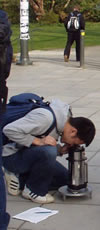Introduction¶
These pages introduce the fundamentals and practicalities of gravity surveying. They are not exhaustive, and are meant only to serve as an introduction.
Gravity Surveys¶
For applications at engineering, exploration and regional or continental geological scales, measurements of Earth’s gravitational field are used to map subsurface variations in density. For geological materials, density ranges from nearly 0 kg/m3 (for voids or snow, dust and similar materials) to roughly 8000 kg/m3 for some rare minerals. Most common geological materials are between 1800 and 3200 kg/m3.

The basis of using variations in gravitational acceleration as a measure of density variations is that the force of attraction between two masses is directly proportional to the two masses, and inversely proportional to the square of the distance between them. If the force of attraction experienced by a fixed mass can be measured carefully at different locations on the earth, the change in this attraction can be related to variations in the mass of materials nearby (i.e. underground). There are other aspects of this experiment that affect the force of attraction experienced by our fixed mass, but these effects can be determined and removed so that the residual variations can be related to the subsurface distribution of density.
Historical perspective¶
The universal law of gravitation has been known since 17th century, when it was founded by Newton. Therefore, investigations of Earth’s gravitation could be considered one of the oldest of geophysical pursuits. In 1735-1745, Pierre Bouguer established relations describing how gravitational attraction varies according to latitude, altitude, and topography. Only somewhat more recently, the effects on Earth’s gravitational field of large topographic features were recognized as significant when British surveyors in India, who were using plumb-bobs for vertical references, encountered significant errors near the Himalaya mountains.
The first exploration applications involved detection of salt domes associated with petroleum resources, using pendulum instruments in the Texas oil patch in the 1920’s. The fundamental sensors used by current portable instruments were developed in the 1930’s and modern ground-based portable systems really only improve on these techniques by automating some of the measurement steps.
There have been three important recent innovations that are changing the extent to which gravity is used in earth sciences. These are the detailing of the earth’s (and other planet’s) shape using satellite orbital paths, the development of reliable airborne gravity measurement techniques, and the acquisition of high accuracy measured (as opposed to calculated) gravity gradients.